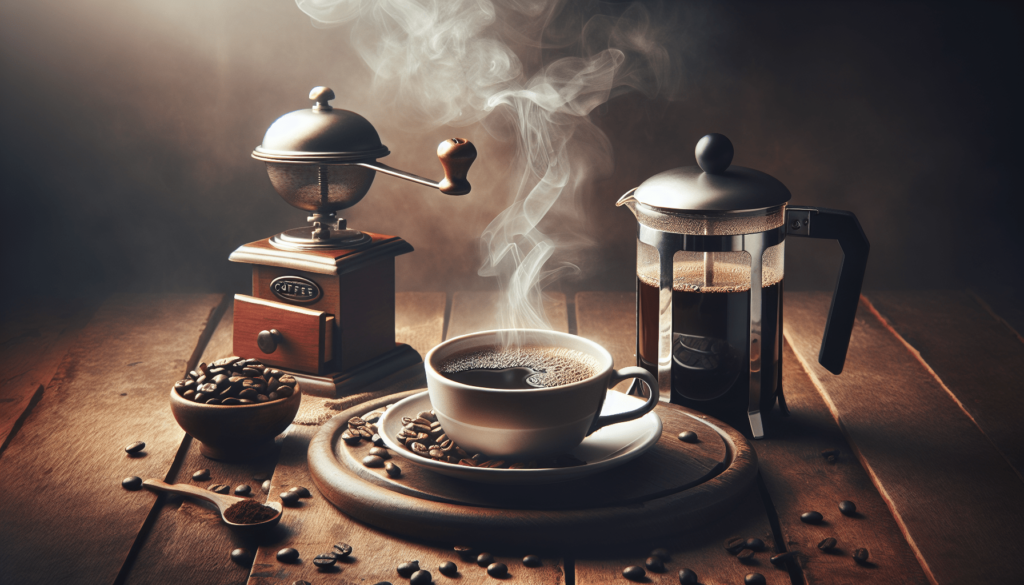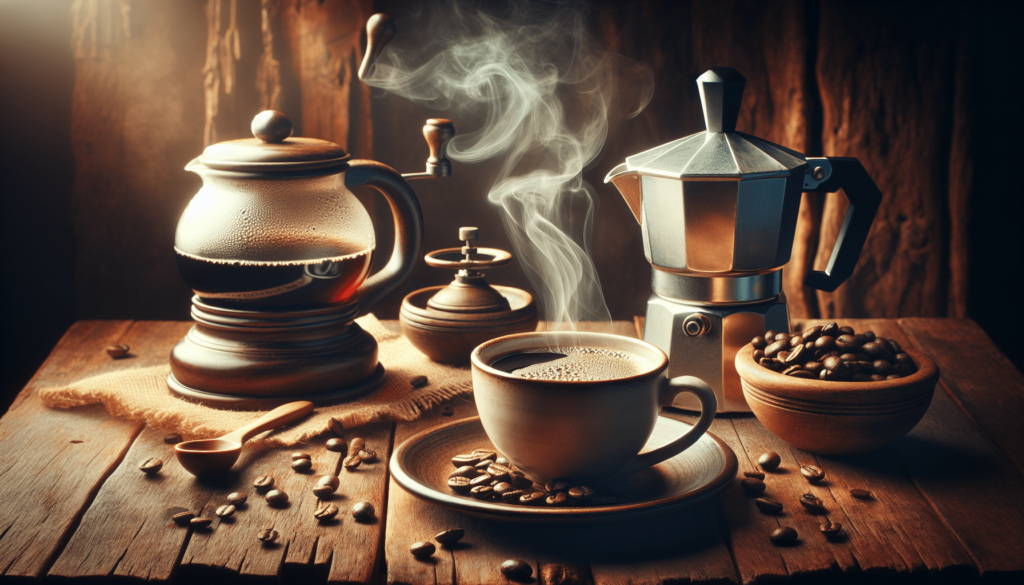Have you ever wondered what exactly coffee brewing entails? Whether you’re a seasoned coffee enthusiast or a curious newbie, understanding the art and science behind brewing coffee can deepen your appreciation for this beloved beverage. With so many methods and variables, it’s worth taking a closer look at what goes into brewing the perfect cup.
What is Coffee Brewing?
Coffee brewing is the process of extracting flavors and aromatic compounds from ground coffee beans using water. This may sound simple, but the complexity of flavors achieved through various methods is astonishing. The act of brewing involves both art and science, combining precise measurements, timing, and techniques to create a beverage that suits your personal tastes.
The Basics of Coffee Brewing
Components
Let’s start with the fundamental components:
- Coffee Beans: The source of your brew. Beans vary in type, region, and roast profile.
- Water: The solvent that extracts the coffee’s flavors. Its quality and temperature matter significantly.
- Grind Size: The consistency of the ground coffee. It can range from coarse to fine.
- Ratio: The proportion of coffee to water.
- Extraction Time: The duration water interacts with coffee grounds.
The Coffee Beans
The type of coffee bean you choose profoundly impacts your final cup. Arabica and Robusta are the two primary species of coffee, each offering unique characteristics. Arabica tends to be smoother and more complex, while Robusta provides a stronger, more bitter taste. The origin of the beans, such as Ethiopian or Colombian, also factors in, contributing regional subtleties.
Water Quality and Temperature
While water might seem trivial, its mineral content, pH level, and temperature are crucial. Ideally, water should be filtered and free from excessive minerals that can alter the taste. The temperature should generally be between 195°F and 205°F for optimal extraction.
Grind Size
Matching the grind size to your brewing method is essential. For example, a coarse grind suits a French press, while a fine grind is best for espresso. Too coarse, and your coffee might be under-extracted; too fine, and it can be over-extracted, leading to bitterness.
Coffee-to-Water Ratio
Getting the right coffee-to-water ratio is key to achieving balance. A general guideline is 1:15 (1 part coffee to 15 parts water), but this can be adjusted based on personal preference.
Extraction Time
Time is of the essence when it comes to coffee brewing. Each method has its own recommended extraction time. Deviations can lead to under-extraction, resulting in sourness, or over-extraction, causing bitterness.

Popular Coffee Brewing Methods
Drip Coffee Maker
A staple in many households, the drip coffee maker is convenient and easy to use. It works by heating water and allowing it to drip through a basket of coffee grounds into a carafe below.
- Pros: Consistent, easy to use, programmable.
- Cons: Limited control over brewing variables.
French Press
A French press, also known as a press pot or plunger pot, involves steeping coarsely ground coffee in hot water before pressing the grounds to the bottom.
- Pros: Full control over water temperature and steeping time, rich and full-bodied flavor.
- Cons: Can be more time-consuming, requires a coarse grind.
Espresso Machine
Espresso machines force hot water through finely-ground coffee under high pressure, creating a concentrated shot of coffee with a distinctive crema on top.
- Pros: Produces concentrated, rich flavor, the basis for various coffee drinks like lattes and cappuccinos.
- Cons: Expensive, requires some skill to operate.
Pour-Over
Pour-over methods involve manually pouring hot water over coffee grounds in a filter, allowing it to drip through into a carafe or mug below. Popular devices include the Chemex and Hario V60.
- Pros: Full control over brewing variables, clean and clear flavor profile.
- Cons: Requires precision and patience, not as convenient.
Aeropress
The Aeropress is a versatile device that uses air pressure to push hot water through coffee grounds, producing a smooth and strong cup of coffee.
- Pros: Quick and portable, easy to clean, versatile brewing options.
- Cons: Limited capacity, requires manual operation.
Moka Pot
Often referred to as a stovetop espresso maker, the Moka pot brews coffee by passing boiling water pressurized by steam through ground coffee.
- Pros: Brews rich, strong coffee similar to espresso, affordable.
- Cons: Can be tricky to master, more hands-on.
Brewing Techniques and Tips
Pre-Infusion (Bloom)
Pre-infusion involves moistening the coffee grounds with a small amount of water before the main brewing process. This helps release trapped gases and enhances the extraction process.
Stirring
Stirring the coffee grounds during brewing can promote even extraction by ensuring uniform saturation. This is particularly important in methods like pour-over or Aeropress.
Grind Consistency
Consistency in grind size is crucial for even extraction. Investing in a quality burr grinder can help achieve this. Blade grinders, while cheaper, offer less consistency.
Clean Equipment
Maintaining clean brewing equipment prevents the build-up of oils and residues that can affect the taste of your coffee. Regular cleaning ensures the purest flavors.
Measuring Tools
Using a kitchen scale to measure coffee and water ensures accuracy and consistency. Even small variations can impact the final taste, so precision is key.

Common Brewing Mistakes and How to Avoid Them
Incorrect Water Temperature
Using water that’s too hot or too cold can negatively affect extraction. Stick to the recommended range of 195°F to 205°F for optimal results.
Inconsistent Grind Size
Irregular grind size leads to uneven extraction, affecting the taste. Ensure your grinder produces consistent grounds suitable for your chosen brewing method.
Wrong Coffee-to-Water Ratio
Using too much or too little coffee disrupts the balance, resulting in overly strong or weak coffee. Stick to recommended ratios or adjust incrementally based on taste.
Over/Under Extraction
Timing plays a critical role. Too short, and the coffee may be acidic; too long, and it might be bitter. Follow method-specific guidelines for best results.
Not Cleaning Equipment
Dirty equipment can introduce off-flavors. Regularly clean all parts of your coffee maker, grinder, and any other equipment to maintain taste quality.
Coffee Brewing and Health
Antioxidants
Coffee is rich in antioxidants, which are beneficial for your overall health. These compounds help combat oxidative stress and inflammation.
Caffeine Benefits
Caffeine, a primary component of coffee, can enhance alertness and concentration. It also has mood-boosting properties.
Moderation
While coffee has health benefits, it’s best enjoyed in moderation. Excessive intake can lead to issues like insomnia or increased heart rate.
Experimenting with Coffee Brewing
One of the joys of coffee brewing is the opportunity to experiment. Here are some areas where you can get creative:
Blends and Single Origins
Try different blends or single-origin beans to explore various flavor profiles. Each has its own unique characteristics influenced by the growing region and processing method.
Grind Fineness
Experiment with grind size to see how it impacts extraction and flavor. Finer grinds generally lead to stronger flavors, while coarser grinds yield a milder cup.
Water Profiles
Different water types can alter the flavor of your coffee. Consider using different water sources or experimenting with mineral additives.
Brewing Times
Adjusting the extraction time can fine-tune the flavor balance. Shorter times might highlight acidity, while longer times can bring out bitterness and depth.
Temperature Variations
Trying slightly different water temperatures can affect the extraction process and the resulting flavors. Small variations can make a noticeable difference.
Specialty Coffee Movements
Third Wave Coffee
Third wave coffee treats coffee as an artisanal product, akin to wine. It emphasizes high-quality beans, precise brewing methods, and transparency in sourcing.
Direct Trade
Direct trade focuses on building direct relationships between coffee producers and roasters, ensuring fairer prices and better quality control.
Sustainability
The specialty coffee community increasingly prioritizes sustainability, from eco-friendly farming practices to compostable packaging.
Coffee and Cultural Rituals
Turkish Coffee
Turkish coffee is prepared using an ibrik (cezve), where finely ground coffee is simmered with water and sugar. It’s a social experience, often accompanied by fortune-telling from the coffee grounds.
Italian Espresso Culture
Espresso is central to Italian coffee culture, enjoyed in small, strong doses. It’s not just a drink but a quick, social ritual often performed standing at a counter.
Japanese Coffee
In Japan, meticulous attention to detail is evident in coffee preparation. Methods like pour-over are refined to an art form, focusing on precision and aesthetics.
Conclusion
Understanding coffee brewing isn’t just for baristas or coffee aficionados. With the right knowledge and tools, you can brew an excellent cup right at home, tailored specifically to your tastes. From choosing the right beans and grind size to mastering various brewing methods, there’s a wealth of factors that contribute to that perfect sip. So next time you make coffee, you’ll appreciate the intricate dance of art and science that goes into every flavorful drop.
